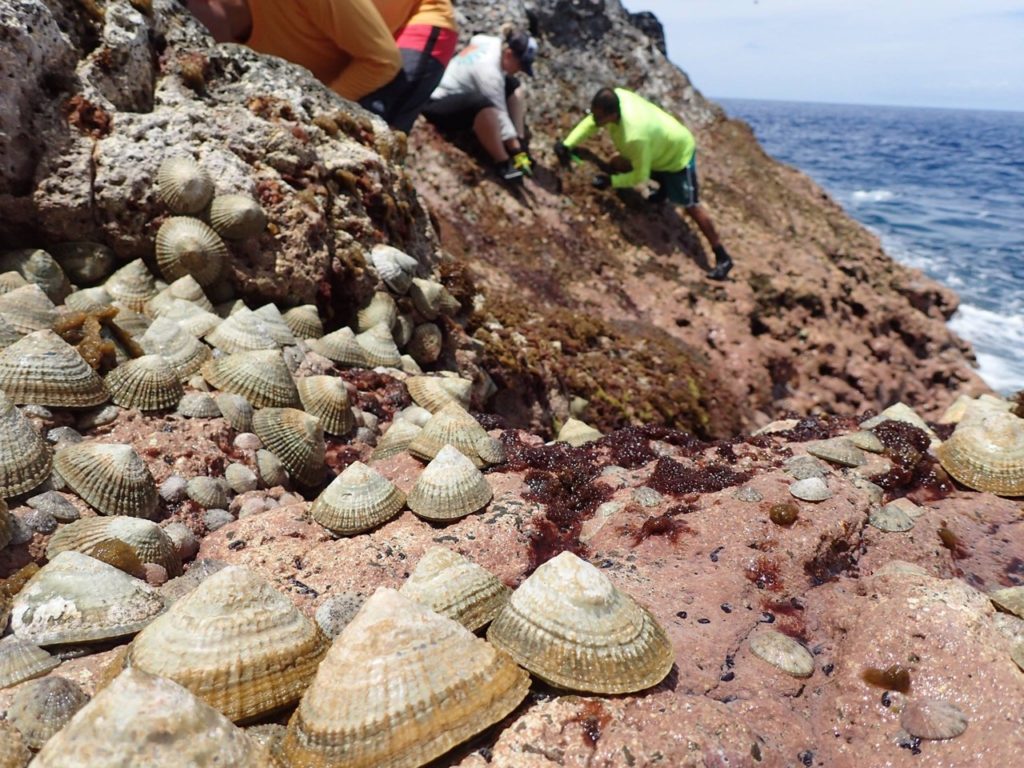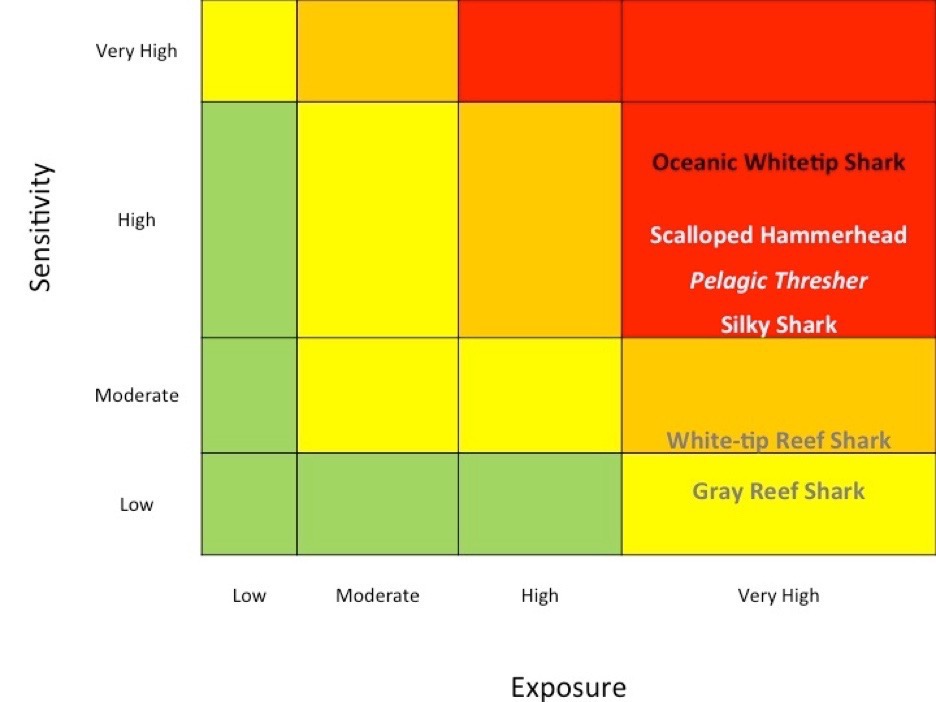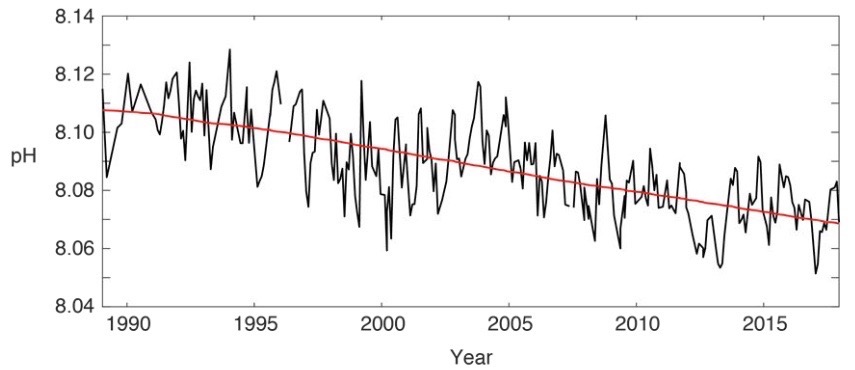
A recent rapid assessment of 83 marine species from throughout the Pacific found that sharks — including the threatened oceanic whitetip — sea cucumbers, urchins and clams are highly vulnerable to expected climate change effects over the next few decades. Limpets, such as opihi, and the tiny Palolo worm are likely to suffer the most, it found.
The assessment, called the Pacific Islands Vulnerability Analysis (PIVA), was conducted by a team consisting mainly of local federally funded scientists and is similar to one done in 2016 for the Northeast continental shelf.
The National Oceanic and Atmospheric Administration’s Fisheries Climate Science Strategy calls for regions across the country to conduct such assessments to help determine which species are the most vulnerable and where science and management should focus their efforts to reduce risk.
The work in the Northeast covered 82 fish and marine invertebrate species and examined their vulnerability to seven climate change factors, including ocean surface temperature, ocean surface salinity, surface air temperature, precipitation, surface pH, currents, and sea-level rise.
The scientists found that bay scallops and Atlantic salmon were the most vulnerable, scoring “very high” in both their exposure and their sensitivity to those factors.
More than half of the species were likely to be negatively affected by climate change, about two dozen species would experience neutral effects, and 14 species, including butterfish, black sea bass, and anchovies, were expected to benefit.
For the Hawai‘i project, the scientists expanded their analysis to include 18 climate change factors, including changes in oxygen levels and sea bottom temperature.
Last month, Pacific Islands Fisheries Science Center fishery biologist Don Kobayashi, who worked on the assessment with colleagues Jonatha Giddens and Mark Nelson, provided the Western Pacific Fishery Management Council’s Scientific and Statistical Committee with an overview of the project and its results.
He explained that the team took the best estimates of the species’ distribution and combined that with NOAA forecasts of climate change effects (such as changes in ocean pH) to produce more than 5,200 exposure maps that “basically show you how much climate change will be happening over a species’ range.”
The group assessed how sensitive each species was to each of those environmental changes. It then combined their exposure and sensitivity scores to produce an overall vulnerability score.
The Pacific project did not analyze corals or protected species (other than the oceanic whitetip shark), because those are being handled by a different group, Kobayashi said.
Lower surface oxygen, high sea surface temperature, and ocean acidification turned out to be the three factors that had the most impact. Those factors “bumped exposure into the very high range for nearly all of our taxa,” Kobayashi said.
The species covered six functional groups: deep slope, coastal, coral reef, pelagics, sharks, and invertebrates.
“Coastal was clustered toward the moderate [vulnerability realm]. Sharks were inching up into the high and very high,” he said.
Oceanic whitetip, scalloped hammerhead, pelagic thresher, and silky sharks all were determined to face very high exposure to climate change factors and to be highly sensitive to them. Whitetip reef and gray reef sharks also faced very high exposure, but their sensitivity was assessed as moderate and low, respectively.

Credit: Courtesy of Don Kobayashi
“The invertebrate group ranked as most vulnerable and pelagic and coastal groups ranked as least vulnerable. … The sensitivity of many coral reef fishes ranged between Low and Moderate, which is likely an underestimate given that reef species depend on a biogenic habitat that is itself extremely threatened by climate change,” a summary of the assessment states.
“Within its limitations, this project advances our understanding of the research needs and the management options to sustain both marine life and seafood security in the Pacific Ocean and beyond,” it states.
‘Ecosystem Context’
The assessment’s results regarding pelagic fish species such as bigeye tuna suggest that while their exposure to climate change effects may be very high, the fish are only moderately or minimally sensitive to them.
But that assessment covers climate effects only through 2055, and compares only two time blocks — 1956-2005 vs. 2006-2055 — to determine the relative changes in the environment.
Research by other current and former NOAA scientists suggests that by the end of the century, a large drop in primary productivity in the North Pacific will lead to a corresponding drop in the ability of the region around the subtropical gyre to support many species, including the pelagic species that the Hawai‘i longline fleet targets. (See the cover story for more on this topic.)
Such studies, Kobayashi explained in an email to Environment Hawai‘i, evaluate environmental changes that occur out to 2100, “and might do a more extreme comparison which will accentuate the small predicted changes over time. Neither approach is flawed.”
For PIVA, he said the team followed the same approach as the Northeast for consistency, adding that the assessment can be viewed as “not presenting endpoint extremes, but more like the immediate, contemporary-human-lifespan-scale experience of climate change impacts.”
At the SSC meeting, Pacific Island Fisheries Science Center director Mike Seki asked Kobayashi whether the assessment team had given any thought to conducting an ecosystem vulnerability analysis that takes into account climate change effects on lower trophic levels.
“A lot of expected impacts are coming through the trophic relationships. It’s hard to look at climate impacts without looking at the community,” especially with regard to pelagic species, Seki said, adding, “The agencies tend to not look at the system as whole.”
“I totally agree looking at an ecosystem context is the way to go,” Kobayashi replied. He explained that in trying to assess potential ecological impacts, the assessment team looked not just at species of harvest interest, but also “any species that could potentially serve as a big player in the ecosystem in some aspect.”
“This is certainly a first crack at it,” he said.
In his email, Kobayashi added that lower trophic level measurements of both productivity and chlorophyll were among the exposure variables analyzed by PIVA.
And in the sensitivity scoring, the team also took productivity and ecosystem responses into account, he said. (Sensitivity attributes included habitat and prey specificity, sensitivity to ocean acidification and temperature, stock size/status, adult mobility, spawning cycle, complexity in reproduction, early life history survival and settlement requirements, population growth rate, dispersal of early life stages, and other stressors.)
“So short answer, I don’t think any ecosystem responses slip through the cracks of PIVA, even though we don’t directly talk about my favorite group of plankton,” he said.
Other Applications
At the SSC meeting, chair Jim Lynch asked Kobayashi whether the assessment could be applied to the ongoing consultations that the National Marine Fisheries Service is conducting in accordance with Section 7 of the Endangered Species Act.
For example, the agency is in the midst of consultations for longline and purse seine fleets in the Western Pacific, which incidentally catch and kill oceanic whitetip sharks.
Kobayashi said he didn’t know about Section 7 applications, but thought PIVA could be useful in stock assessments, which he said often don’t consider environmental factors enough. SSC member Milani Chaloupka agreed, noting that the exposure maps the team produced would be especially helpful.
Whether or how the Western Pacific Fishery Management Council will incorporate the assessment results into its annual recommendations on catch limits for those species that fall under NMFS management jurisdiction remains to be seen. And Kobayashi did not suggest that any such incorporation start now.
“I’m not suggesting the next step is a management strategy evaluation on bigeye tuna or oceanic whitetips. [We’re just] trying to get an idea of what species we should look at and bring them into the PIVA scoring,” he said.
Shifting Distributions, Changing Productivity
Where will the bigeye tuna that the Hawai‘i longline fleet targets be in the coming decades as the ocean warms? And will there continue to be enough of them to support a robust commercial fishery?
Last November, recognizing that climate change may shift the distribution of harvested species and affect their productivity — be it through rising ocean temperatures, ocean acidification or some other factor — the National Marine Fisheries Service issued a technical memorandum describing a six-step process to help regions deal with the myriad scenarios they’re likely to encounter. The service recommended they 1) detect and anticipate changes, 2) understand mechanisms of change, 3) evaluate risks and priorities, 4) conduct assessments and develop forecasts, 5) communicate advice to manager and stakeholders, and 6) manage fisheries under changing conditions. To achieve each of those, the memo recommended a total of 20 specific actions.
The Northeast and Pacific vulnerability assessments are the kind of research the memo recommends be done under step 3. The Northeast study found that 55 of the 82 species were highly or very highly vulnerable to changes in their distribution. The Pacific study found that the distribution of pelagic species, most of the sharks, coastal scads and the giant trevally were apt to shift.
To detect the kinds of changes that might influence productivity or distribution of key species (step 1), the annual Stock Assessment and Fishery Evaluation (SAFE) reports released by the Western Pacific Fishery Management Council have in recent years been tracking several indicators, such as ocean pH, phytoplankton size and abundance, and sea temperatures at the surface and at depth, among other things.
“Bigeye have preferred thermal habitat, generally staying within temperatures ranging from 8 – 14 °C while they are at depth. Changes in ocean temperature at depth will impact tuna, and in turn, potentially impact their catchability,” according to the council’s 2018 SAFE report for pelagic fisheries.
Last year, temperatures 200 – 300 m deep were “within the range of temperatures experienced over the past several decades (10.87 – 11.58 °C) and are within the bounds of bigeye tuna’s preferred deep daytime thermal habitat (8 – 14 °C),” the report states.
The data on ocean acidity — which can affect the ability of fish and their prey to build bones or other calcareous structures — was not so benign.
“The ocean is roughly 9.4 percent more acidic than it was nearly 30 years ago at the start of this time series,” the report states. “[S]mall variations seen over the course of the year are now outside the range seen in the first year of the time series [1990]. The highest pH value reported for the most recent year (8.0831) is lower than the lowest pH value reported in the first year of the time series (8.0845),” it continued.

Credit: Western Pacific Fishery Management Council SAFE Report
Management Implications
At the council’s Scientific and Statistical Committee meeting last month, Melissa Karp, of ECS Federal, LLC, on behalf of NMFS’ Office of Science and Technology, detailed the various step-related recommendations included in the memo. None of them amounted to a “silver bullet,” but they might allow regional fisheries to be “robust to climate change,” she said.
She recommended that regions capitalize on advancements in models, citing the Alaska Climate Change Integrated Modeling (ACLIM) project that looks to predict climate-driven changes in the Bering Sea.
“ACLIM uses global climate models and climate enhanced biological models, as well as economic models that give the big picture,” she said.
With regard to management, she said regions need to plan for future scenarios using results from risk assessments. “Some species may be crossing jurisdictional boundaries. Plan for emerging fisheries if new species enter your regions [and] run scenarios with adjacent jurisdictions,” she said.
She also recommended the use of near- real-time data that fishermen can use to avoid areas with predicted high abundance of protected resources and, therefore, lower bycatch and “allow for smaller area closures that are more dynamic.”
SSC member Ray Hilborn, an outspoken skeptic of large marine protected areas, said he was really happy with the memo’s recommendations.
“It’s very clear stocks are subject to directional change and distribution and fluctuating … higher and lower productivity. It’s time to move beyond everything is stationary,” he said.
Given the unpredictability of stock performance, he said, “I’d be concerned if NOAA was to spend a lot of resources to predict what changes will take place. … It’s more important to adapt to the changes that take place.”
SSC member Kurt Schaefer of the Inter-American Tropical Tuna Commission added that trying to determine shifts in species distributions will be a monumental and expensive undertaking.
Even so, NMFS plans to start compiling species distribution information across the nation. “I agree that’s a big effort, but that’s an important effort,” Karp said.
SSC member Erik Franklin of the University of Hawai‘i’s School of Ocean and Earth Science and Technology said he was more concerned with potential declines in productivity, and maybe shifts in species composition, as a result of nearshore habitat loss.
He asked Karp whether NMFS was planning to issue a similar memorandum for insular areas. Karp replied that she’d not thought about it, beyond what’s already been done in the PIVA.
Marlowe Sabater, the council’s marine ecosystem scientist, asked Karp what NMFS’s next step will be policy-wise. “Is this something headquarters is going to recommend to each region to start adopting … for any kind of management decisions?”
Patrick Lynch, also with the service’s science and technology office, said Sabater shouldn’t expect anything too formal. “We released the tech memo as a guidance framework. … It’s up to the regions to do what they will with these recommendations.”
—Teresa Dawson

Leave a Reply